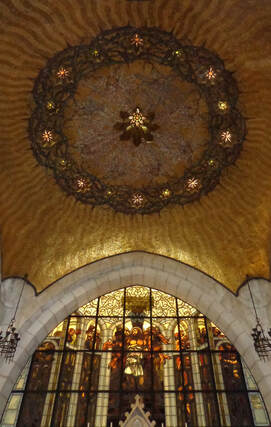|
Read: Luke 23 (www.biblestudytools.com/nrs/luke/23.html)
Sing: Ah, Holy Jesus, UMN 289 “The Way of Sorrows” is the traditional route that Jesus carried his cross to his execution. We were on part of the Via Dolorosa as soon as we stepped onto the street where we could see Hadrian’s Arch. At that point, the Way of Sorrows stretched in front of us and behind us. Each Friday, Franciscan friars lead a procession beginning at 3pm (4pm in the summer) and starting in the Al-Omariya Madrasa (Station 1). The procession moves west and ends at the Church of the Holy Sepulchre (Stations 10-14). Each procession is accompanied by Muslim guards in Ottoman uniforms. The route, and the number and location of stations, has changed over the centuries. But walking the Via Dolorosa has been a Christian tradition since the 4th or 5th century. Today’s route was established in the 18th century with the present 14 stations, though some of the station locations were changed in the 19th century. Though we did not get to follow the entire route of the Via Dolorosa on this day, I think that it is a wonderful devotional act. It began as a way for people who could not travel to Jerusalem to experience viscerally, the sorrow of the first Good Friday. You, too, can walk The Way of Sorrows right now where you are. Chapel of the Flagellation (Station 2) The Chapel of the Flagellation is (in my opinion) the most striking of all the churches, chapels, and basilicas we visited. It is, of course, a somber place that evokes quiet and contemplation. The inside of the chapel is dominated by browns, grays, and black and the lighting is subdued. As you enter your eyes are immediately drawn to the three stained-glass windows behind the altar and on either side of the sanctuary. Viewing clockwise, they show Pilate washing his hands, Jesus being scourged, and Barabbas expressing joy at his release. Then, as you absorb this tragic scene while walking up the center aisle, your eyes are drawn upward. On the ceiling above the altar, a mosaic, on a deep golden background, depicts Jesus’ crown of thorns pierced by stars. The affect is absolutely stunning! As I stood surrounded by these light-stopping windows and over-shadowed by this diadem of pain I felt the power of his sacrifice for me in a way that I never had before. The architect was Antonio Barluzzi. This place is a wonderful example of the power of art. Chapel of the Condemnation and Imposition of the Cross (Station 2) Across the courtyard is the Chapel of the Condemnation and Imposition of the Cross which is the traditional site where Jesus was condemned to crucifixion and where he was compelled to take up the crossbeam on which he was to die. As we walk the Way of Sorrows we need to remember that no one took Jesus’ life from him, he gave his life so that you and I might live. Jesus took up his cross and started toward Golgatha from this place. But he had been on his way here since Adam and Eve ate the forbidden fruit.
0 Comments
Leave a Reply. |
AuthorIn matters of faith, we at First United Methodist Church, Sealy put primary reliance on the Bible. In scripture, we understand that we are all God’s children; therefore, we will be a church that cares for the needs of our church and local community through prayer, deeds, inspiration, and love in the spirit of Christ. Archives
July 2020
Categories |
Location |
Our MissionCaring for the needs of our church and community through prayer, deeds, inspiration and love in the Spirit of Christ.
Sunday Worship: 10 am Adult & Children & Youth Sunday School 9 am First Kids Mother's Day Out (Tuesday & Thursday; 8am to 2pm; Ages 1-3) Rev Pat Bell, Pastor First United Methodist Church Sealy
200 Atchison Street Sealy, Texas 77474 979.885.2223 |
Contact Us |

 RSS Feed
RSS Feed